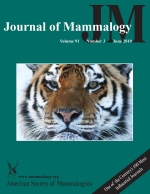Mitigation of predation risk promotes high-elevation dispersion prior to birthing in many ungulate populations. Coyotes (Canis latrans) account for nearly 80% of pronghorn (Antilocapra americana) fawn mortality in Yellowstone National Park, but reintroduced gray wolves (Canis lupus) and factors associated with mountainous terrain can strongly influence space use by predators during summer and are likely to underlie significant spatial variation in survival rates of pronghorn fawns. We used generalized logit models paneled by maternal identity to assess the relative and interactive influences of summer wolf density, winter snow depth, and terrain slope on survival of pronghorn fawns in Yellowstone during 1999–2001 and 2004–2006. In this partially migratory population only migrant pronghorn accessed areas where wolves were numerous and winter snow depths were high. Survival of migrant fawns was higher in areas that experienced deep winter snow and had steeper slope. The influence of wolves on fawn survival was positive only in areas of low winter snowfall where coyotes were abundant, supporting predictions of a coyote-mediated effect of wolves and winter snowfall on pronghorn reproductive success. Our results suggest that deep winter snow, coupled with constraints on mobility imposed by reproduction in populations of social carnivores, can lead to the formation of high-elevation refugia for migrant ungulates. This research offers novel insights into the indirect effects of wolf restoration and climatic factors on the Yellowstone predator–prey complex and a conceptual framework for examining the ecological effects in other mountain communities of restoration of, and seasonal space use by, large carnivores.
How to translate text using browser tools
16 June 2010
Influences of wolves and high-elevation dispersion on reproductive success of pronghorn (Antilocapra americana)
Kerey K. Barnowe-Meyer,
P. J. White,
Troy L. Davis,
Douglas W. Smith,
Robert L. Crabtree,
John A. Byers
ACCESS THE FULL ARTICLE

Journal of Mammalogy
Vol. 91 • No. 3
June 2010
Vol. 91 • No. 3
June 2010
coyote
dispersion
fawn survival
partial migration
pronghorn
reproduction
wolves




